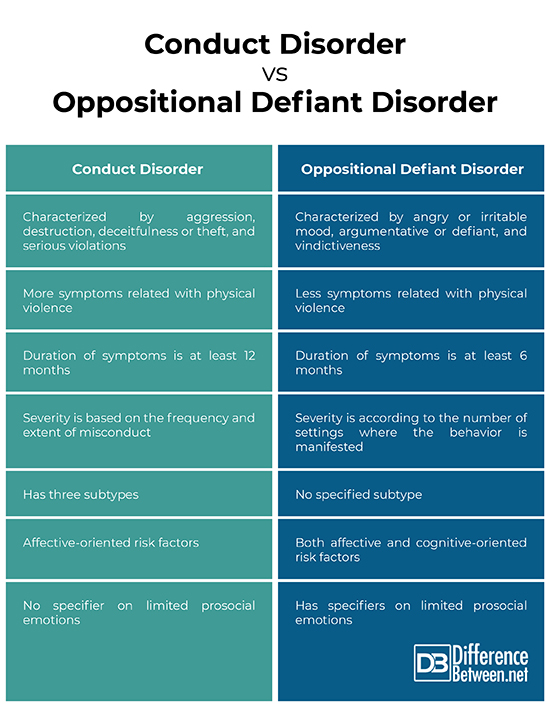Difference Between Conduct Disorder and Oppositional Defiant Disorder
Oppositional defiant disorder (ODD) and Conduct Disorder (CD) are among the prevalent disruptive behaviors in both children and adolescents. These disorders are under the “Disruptive, Impulse-Control, and Conduct Disorders” in the fifth edition of the Diagnostic and Statistical Manual of Mental Disorders (DSM 5). Hence, such behaviors are characterized by self-control issues, aggression, and conflict with social norms.
Moreover, these disorders have been linked with disinhibition and negative emotionalism as well as inversely correlated with constraint personality dimensions. This makes them co-morbid with each other as well as with attention deficit hyperactivity disorder (ADHD). Regarding their distinctiveness, the main diagnostic criteria for ODD are angry or irritable mood, argumentative or defiant behavior, and vindictiveness while those for CD are aggression to people and animals, destruction of property, deceitfulness or theft, and serious violations of rules. The following discussions further delve into such differences.
What is Conduct Disorder?
According to the DSM 5, CD is a “repetitive and persistent pattern of behavior in which the basic rights of others or major age-appropriate societal norms or rules are violated”. The manual furthered that the following criteria should be met in the past 12 months.
The individual often does the following:
Aggression to People and Animals
- Bullying, intimidating, or threatening
- Initiating physical fights
- Using weapons which can cause serious harm
- Physically cruel to people and animals
- Stealing with confrontation like extortion and mugging
- Sexual harassment
Destruction of Property
- Setting fire with the intention of harm
- Destroying others’ property aside from setting fire
Deceitfulness or Theft
- Breaking into a property
- Lying for selfish reasons
- Stealing without confrontation like shoplifting
Serious Violations of Rules
- Staying out late at night (despite curfews), beginning before 13 years old
- Running away from home
- Truancy in school before age 13
What is Oppositional Defiant Disorder?
The DSM 5 states that ODD has at least four of the following diagnostic criteria which lasts for at least six months and is manifested during non-sibling interaction.
The individual often manifests the following:
Angry/Irritable Mood
- Losing one’s temper
- Getting easily annoyed
- Feels resentful or angry
Argumentative/Defiant Behavior
- Arguing with others
- Defying rules or requests
- Annoying others deliberately
- Blaming others for one’s mistakes
Vindictiveness
- Being spiteful
Difference between Conduct Disorder and Oppositional Defiant Disorder
-
Diagnostic Criteria
The diagnostic criteria for CD are aggression, destruction, deceitfulness or theft, and serious violations. On the other hand, those for ODD are angry or irritable mood, argumentative or defiant, and vindictiveness.
-
Physical Violence
It can be observed from the respective criteria of the disorders that CD is more characterized by physical violence as compared to ODD. The former includes physical fights, mugging, rape, and arson while the latter generally deals with upset moods, nonconformity, and spitefulness.
-
Duration of Symptoms
The symptoms of ODD must last for at least 6 months while that of CD must last for at least 12 months with at least one criterion being met in the past 6 months. Generally, it will take a longer observation time for the diagnosis of CD to be finalized.
-
Severity
The diagnosis for ODD is specified to be mild if the symptoms are merely confined to a certain setting, moderate if manifested in 2 settings, and severe if present in at least three settings. As for CD, the severity is marked according to the frequency and extent of conduct problems. It is mild if there are few conduct issues which cause only minor harm, moderate if the occurrence of conduct problems is intermediate between mild and severe, and severe if there are many conduct problems and considerable harm is done.
-
Subtypes
There are three subtypes for conduct disorder: childhood-onset type, adolescent-onset type, and unspecified-onset type. On the other hand, oppositional defiant disorder has no specified subtypes.
-
Temperamental Risk Factors
The temperamental risk factors for ODD are high emotional reactivity levels, low frustration tolerance levels, and other emotional regulation dimensions. In the case of CD, the pertinent elements are difficult and uncontrolled infant temperament as well as a below average IQ (particularly verbal intelligence). Thus, those of ODD are more affective-oriented while those of CD are a combination of affective and cognitive.
-
With Limited Prosocial Emotions
The DSM 5 states that it must be specified if the CD is characterized by limited prosocial emotions such as lack of remorse or guilt, being callous or lack of empathy, unconcerned regarding performance, and shallow affect. However, the specifiers for OD did not include similar qualifiers.
Conduct Disorder vs Oppositional Defiant Disorder
Summary of Conduct Disorder Vs. Oppositional Defiant Disorder
- Oppositional defiant disorder (ODD) and Conduct Disorder (CD) are among the prevalent disruptive behaviors among both children and adolescents.
- Regarding their distinctiveness, the main diagnostic criteria for ODD are angry or irritable mood, argumentative or defiant behavior, and vindictiveness while those for CD are aggression to people and animals, destruction of property, deceitfulness or theft, and serious violations of rules.
- CD is more characterized by physical violence as compared to ODD.
- The symptoms of ODD must last for at least 6 months while that of CD must last for at least 12 months with at least one criterion being met in the past 6 months.
- Severity of CD is based on the frequency and extent of misconduct while that of ODD is according to the number of settings where the behavior is manifested.
- CD has three subtypes while ODD has none.
- CD has affective-oriented risk factors while ODD has both affective and cognitive-oriented risk factors.
- Unlike CD, ODD has specifiers on limited prosocial emotions
- Difference Between Hematoma and Melanoma - February 9, 2023
- Difference Between Bruising and Necrosis - February 8, 2023
- Difference Between Brain Hematoma and Brain Hemorrhage - February 8, 2023
Search DifferenceBetween.net :
Leave a Response
References :
[0]American Psychiatric Association. Diagnostic and Statistical Manual of Mental Disorders, 5th Ed. Washington, DC: American Psychiatric Publishing, 2013. Print.
[1]Hollander, Barbara. Conduct Disorder (Teen Mental Health). New York, NY: Rosen Pub Group, 2014. Print.
[2]Walls, Scott. Oppositional Defiant and Disruptive Children and Adolescents. Eau Claire, WI: PESI Publishing, 2016. Print.
[3]Image credit: https://www.flickr.com/photos/chexed/1546923312
[4]Image credit: https://pixabay.com/en/girls-children-kids-267682/



